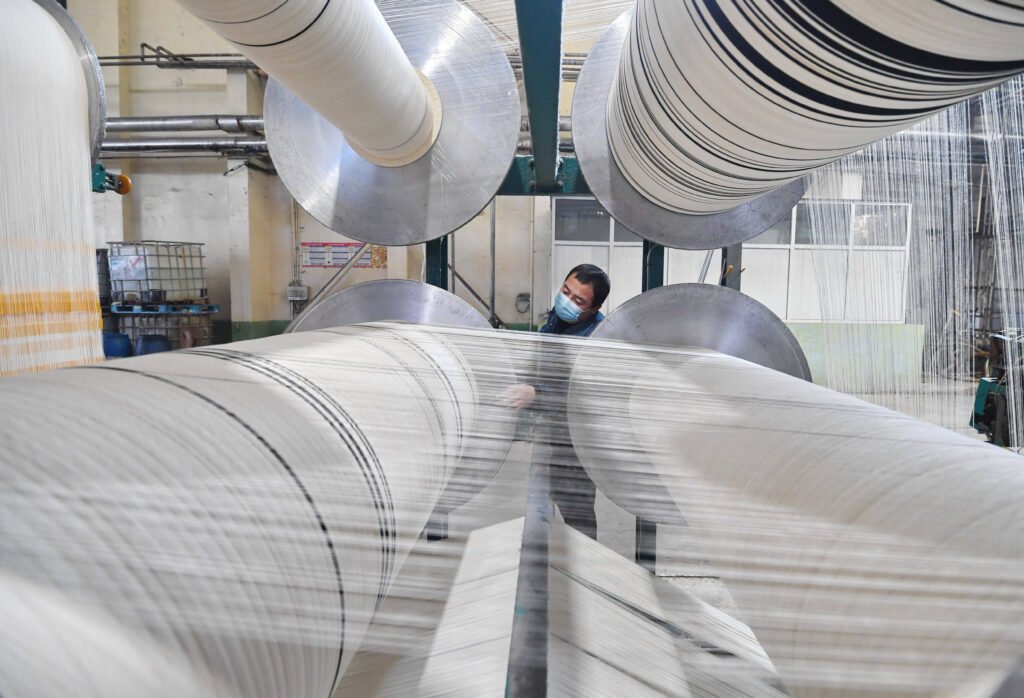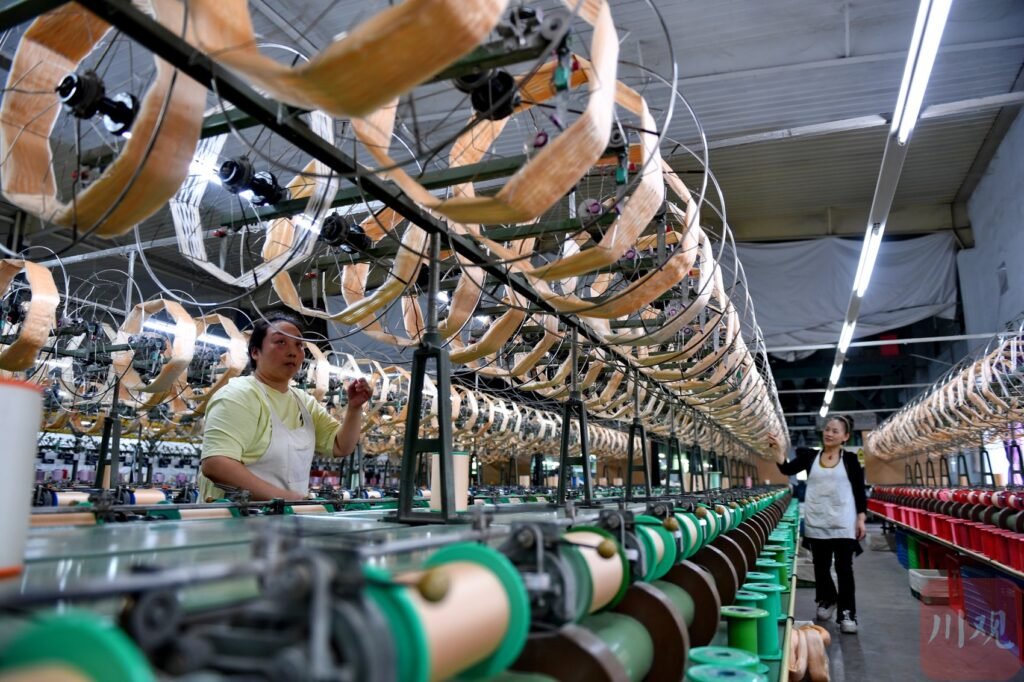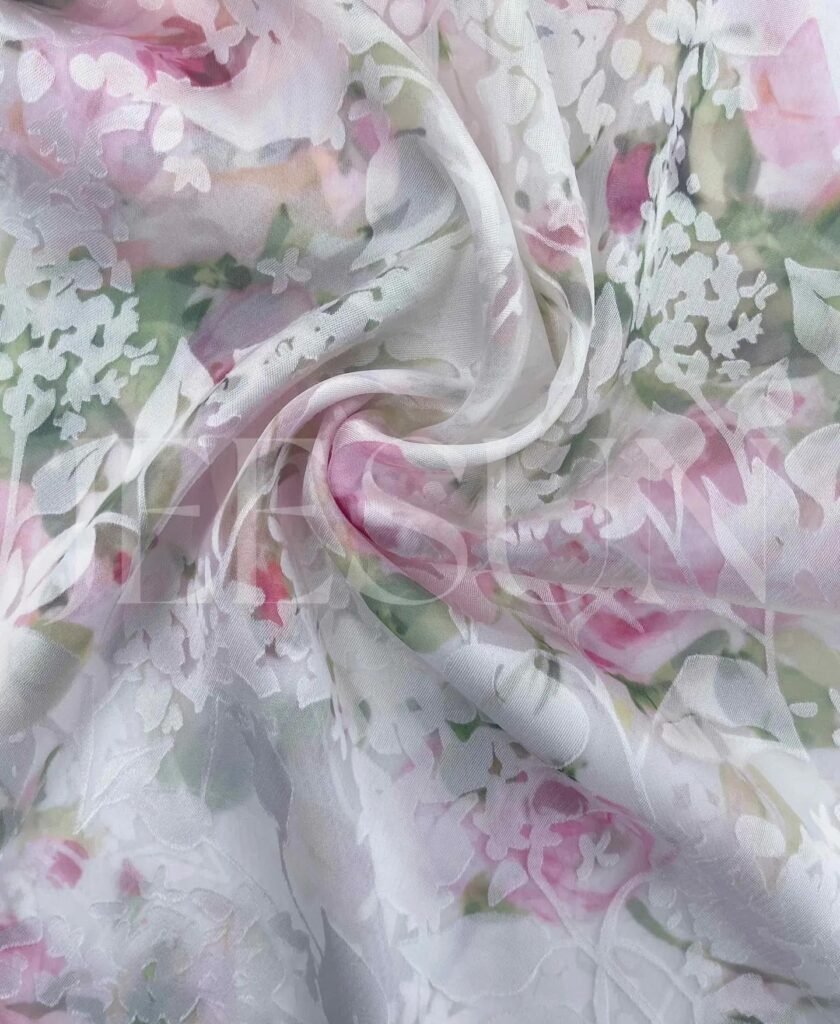
In the global textile trade, few fabrics are as symbolic of luxury and tradition as silk. From the looms of Suzhou to the artisanal clusters in Varanasi and the emerging workshops in Vietnam, silk has become more than just a fiber—it’s a global commodity, a cultural icon, and a strategic material for high-end and sustainable fashion brands. But as a B2B buyer, how do you determine which country’s suppliers truly offer the best balance of quality, consistency, price, and service?
China, India, and Vietnam are currently the top three suppliers in the global silk market, but their products differ significantly in fiber type, grade reliability, production scale, pricing, and export customization. Understanding these differences helps you choose the right source for your brand’s needs.
In this article, we’ll audit the top silk-producing countries from the lens of quality grading, fabric types, price points, MOQ flexibility, and OEM support. Whether you’re sourcing bridalwear fabric, luxury bedding, or eco-conscious scarves, you’ll find concrete data and supplier insights to make a well-informed decision.
Let’s begin by understanding why these three countries dominate the silk supply chain—and what makes each of them unique.
What Makes China, India, and Vietnam the Leading Silk Fabric Suppliers Worldwide?
China, India, and Vietnam are the top three players in silk production globally, contributing over 95% of the world’s mulberry silk output. Their dominance comes from centuries of sericulture tradition, government-supported textile infrastructure, and a wide range of silk grades and finishes.
China leads the global silk market due to its advanced production scale and high-grade output. India is known for its traditional craftsmanship and variety of wild silks, while Vietnam offers emerging quality and lower MOQs, appealing to boutique brands.
Why These Countries Lead in Silk Production
1. Historical and Cultural Foundations
- China: Over 4,000 years of silk history. Home of Mulberry silk and birthplace of 6A-grade classification.
- India: Rich heritage in wild silk (Tasar, Muga, Eri). Major producer of handwoven silks.
- Vietnam: Growing quickly in both machine-woven and handloom silk with lower labor costs.
2. Production Volume and Global Market Share
| Country | Global Mulberry Silk Market Share (%) | Production Style | Notable Strengths |
|---|---|---|---|
| China | \~70% | Industrialized, scalable | High-quality 6A silk, customization |
| India | \~20% | Handloom & semi-mech | Wild silk types, artisanal finishes |
| Vietnam | \~5–7% | Mixed (rural-industrial) | Lower MOQ, developing export support |
3. Key Export Destinations
- China: U.S., Japan, Italy, Germany
- India: Middle East, U.K., France, Southeast Asia
- Vietnam: Korea, EU, Australia, U.S.
4. Government Support & Certifications
- China has sericulture R\&D centers and certification frameworks (e.g., OEKO-TEX, ISO).
- India offers GI certification for silk clusters like Kanchipuram.
- Vietnam benefits from trade agreements like EVFTA (EU-Vietnam Free Trade Agreement), easing export duties.
5. Real Buyer Insight
A U.S. bridalwear importer recently shared:
“We love China’s 6A silk for gowns, but India’s Eri silk gives our casual line an earthy, organic feel. Vietnam surprised us with flexible MOQ—perfect for limited collections.”
How Does Silk Fabric Quality Compare Among China, India, and Vietnam?

Silk fabric quality can differ greatly based on fiber uniformity, dye uptake, texture, and finish. China is widely considered the gold standard for high-grade silk (particularly 6A Mulberry silk), while India offers a wide spectrum from handwoven raw silks to luxe wild silks. Vietnam, while newer to the game, is making significant progress in consistency and weaving techniques.
China leads in high-grade, machine-finished silk quality. India offers artisanal diversity with wild silk textures, while Vietnam provides smooth, semi-industrial silk with rising grade consistency—especially appealing for small brands and fast-moving collections.
Comparative Analysis of Quality
1. Silk Type and Grading Consistency
| Country | Main Silk Types | Grading System | Quality Notes |
|---|---|---|---|
| China | Mulberry (6A/5A/4A) | Standardized | Glossy, even, suitable for premium use |
| India | Mulberry, Muga, Eri, Tasar | Varies by region | Natural finish, often raw & textured |
| Vietnam | Mulberry | Emerging standards | Balanced sheen, improving consistency |
- China’s silk is prized for thread uniformity, making it ideal for machine dyeing and digital printing.
- India’s silk tends to be more textured and may require manual color matching during garment production.
- Vietnamese silk still varies by region, but urban suppliers now offer digital-ready Mulberry silk.
2. Thread Count & Momme Options
- China: Full range (from 8 to 30 momme), especially strong in 19–22 momme charmeuse and crepe de chine.
- India: High on slubbed textures, Eri blends, low-momme wild silk.
- Vietnam: 12–22 momme, mostly satin and organza. Best for fashion-forward buyers who need smaller quantities with decent quality.
3. Consumer-Facing Quality Perception
- China = “Luxury smoothness”
- India = “Natural handmade richness”
- Vietnam = “Underrated quality at smart price”
A Berlin-based loungewear brand uses 22-momme 6A silk from Suzhou for its top-tier line, but offers an eco-friendly weekend wear set using Indian Eri silk, emphasizing traceability and “slow fashion” branding.
Which Country Offers the Most Consistent Silk Grading Standards (6A/5A/4A)?
Among global silk suppliers, China offers the most recognized and consistent grading system, particularly for Mulberry silk. The A-grade classification—ranging from 3A to 6A—is internationally accepted and helps B2B buyers easily evaluate silk based on fiber length, uniformity, color, and tensile strength. India and Vietnam, while producing excellent silk, lack a universally applied grading system, leading to occasional confusion or misalignment in buyer expectations.
China provides the most reliable silk grading standards with widely adopted 6A/5A/4A classifications, while India and Vietnam use more localized or supplier-specific quality assessments, making Chinese silk easier to evaluate for global buyers.
Understanding Grading Systems by Country
1. China’s Universal Grading Standards
| Grade | Fiber Length | Uniformity | Common Use Cases |
|---|---|---|---|
| 6A | 750m+ | Excellent | Bridalwear, luxury bedding, couture |
| 5A | 600–750m | Good | Scarves, mid-market fashion |
| 4A | 500–600m | Moderate | Linings, casual accessories |
- China’s CIQ certification (China Entry-Exit Inspection and Quarantine) ensures standard adherence.
- Most Chinese silk exporters provide test reports or certification upon request.
2. India’s Regional Grading Complexity
- India does not follow a centralized A-grade system. Instead, quality is regionally defined:
- Kanchipuram Silk = purity by zari percentage.
- Muga Silk = known for golden hue, graded by color depth and fineness.
- Eri Silk = often categorized by spinning technique (hand vs semi-automatic).
Buyers must visit or trust local vendors to verify authenticity or get 3rd-party textile lab testing.
3. Vietnam’s Evolving Standards
- Vietnam’s silk is generally sold without formal grading, but top manufacturers are moving toward China-style grading language (e.g., “6A-like” or “premium Mulberry silk”).
- Certifications from Vietnam Textile & Apparel Association (VITAS) or ISO/SGS may be available on request.
A Paris-based designer sourcing from all three countries shared: “With China, I can specify 6A and get exactly what I expect. In India or Vietnam, I need to verify quality through swatches or lab tests—especially when ordering above 300m.”
What Types of Silk Are Produced in Each Country and How Are They Used?

Silk types vary significantly among China, India, and Vietnam—not just in names, but also in their texture, sheen, dye behavior, and end-use suitability. Understanding these differences is crucial for selecting the right fabric for your target product—whether it’s smooth satin pillowcases or rustic artisan scarves.
China primarily produces high-grade Mulberry silk, India offers diverse wild silks like Muga and Eri, and Vietnam focuses on lightweight Mulberry silk with satin and organza weaves—each suiting different product needs.
Silk Types by Country
1. China: Precision-Finished Mulberry Silk
| Silk Type | Description | Best For |
|---|---|---|
| Charmeuse | Glossy front, dull back, soft drape | Bridalwear, lingerie |
| Crepe de Chine | Matte texture, subtle crinkle | Dresses, scarves |
| Habotai | Lightweight, smooth plain weave | Linings, digital printing |
| Silk Organza | Crisp and sheer | Eveningwear overlays, gowns |
Uniform thread, ready for automated dyeing or digital printing.
2. India: Traditional & Wild Silks
| Silk Type | Description | Best For |
|---|---|---|
| Muga | Golden silk, exclusive to Assam | Ceremonial garments, luxury wear |
| Eri | “Ahimsa” silk, no killing of silkworms | Sustainable fashion, scarves |
| Tussar | Coarse texture, natural tan color | Ethnic wear, eco-themed textiles |
| Kanchipuram | Heavyweight, ornate woven silk | Sarees, home décor fabrics |
Natural texture, sustainability stories, cultural value.
3. Vietnam: Lightweight Fashion Silks
| Silk Type | Description | Best For |
|---|---|---|
| Satin Silk | Glossy and fluid | Blouses, scarves |
| Plain Weave | Balanced look and feel | Ready-to-wear clothing |
| Handwoven Silk | Slight texture, often artisanal dyeing | Boutique fashion, accessories |
Lower MOQ, modernized weaving, competitive price for startups.
A Melbourne-based yoga apparel brand orders Eri silk from India for its sustainability story, while sourcing satin silk from Vietnam for limited-edition wraps due to lower MOQ and modern print capabilities.
How Do Prices Per Meter Differ Between Chinese, Indian, and Vietnamese Silk?
When sourcing silk in bulk, the price per meter is one of the most influential factors for B2B buyers. Prices vary significantly across China, India, and Vietnam due to differences in production scale, labor costs, raw material quality, and finishing processes. China’s silk commands a premium for its precision and consistency, while Indian and Vietnamese silk can offer competitive value for brands targeting niche markets or artisan aesthetics.
Chinese silk averages \$25–\$45 per meter for 6A-grade fabrics, Indian silk ranges from \$15–\$35 depending on type, and Vietnamese silk is priced around \$10–\$28, making it attractive for budget-conscious or small-batch buyers.
Silk Fabric Price Comparison by Country
1. Average Wholesale Price Table (Per Meter)
| Country | Grade / Type | Avg. Price (USD) | Key Notes |
|---|---|---|---|
| China | 6A Mulberry (Charmeuse) | \$32–\$45 | Premium finish, digital-print compatible |
| China | 5A Mulberry (Crepe) | \$22–\$30 | Excellent value-to-quality ratio |
| India | Muga Silk | \$25–\$35 | Exclusive and naturally golden |
| India | Eri Silk (handspun) | \$15–\$24 | Eco/sustainable appeal, coarser feel |
| Vietnam | Mulberry Satin | \$18–\$28 | Good sheen, decent consistency |
| Vietnam | Lightweight Plain Silk | \$10–\$18 | Suitable for fast fashion, entry level |
2. Factors Driving Price Differences
- Labor cost: Vietnam offers the lowest; China has higher skilled-labor rates.
- Cocoon yield and reeling method: China’s mechanization improves efficiency.
- Finishing technology: Chinese silk benefits from dye houses with digital print prep.
- Wild vs. cultivated silk: India’s wild silks are more expensive due to manual harvesting.
3. Market Trend Insight
Post-pandemic, China’s 6A silk saw a 12% price increase, while Vietnam maintained pricing thanks to lower energy and processing costs. India experienced mild inflation, mostly in the Muga and Tussar categories.
4. B2B Buyer Examples
- A Dutch bridalwear company pays \$40/meter for 6A silk from Suzhou for dresses.
- A Canadian wellness brand buys \$17/meter Eri silk from India for ethical scarves.
- A Seoul-based fashion start-up sources \$14/meter satin silk from Vietnam for accessories.
Is the MOQ (Minimum Order Quantity) Lower in China, India, or Vietnam for B2B Buyers?

MOQ is a critical factor for international buyers—especially small-to-medium brands or new product testers. While China offers superior quality, its MOQ thresholds are typically higher unless stock fabric is used. India provides more negotiation room, especially with artisan clusters. Vietnam, however, stands out for low-MOQ flexibility, especially in pre-dyed or plain weave silk fabrics.
Vietnam typically offers the lowest MOQs (as low as 20–50 meters), followed by India (50–100 meters), while China’s MOQ for custom silk usually starts at 100 meters, though lower quantities are possible through stock programs.
MOQ Benchmark by Country
| Country | MOQ (Stock Colors) | MOQ (Custom Dye) | MOQ (Custom Print) | Typical Lead Time |
|---|---|---|---|---|
| China | 5–20 meters | 100–200 meters | 30–50 meters | 7–14 days |
| India | 10–30 meters | 50–100 meters | 25–50 meters | 10–18 days |
| Vietnam | 5–10 meters | 20–50 meters | 20–30 meters | 5–10 days |
1. How MOQ Impacts Small Brands
- Startups and custom capsule designers need smaller yardage to test products without overcommitting.
- High MOQ leads to stockpiling risk and cash flow stress for new entrants.
2. Low-MOQ Solutions Offered
- China: Offers “ready-to-dye” 6A fabric rolls for smaller runs; MOQ \~30m.
- India: Clusters allow shared dye lots across buyers with similar colors.
- Vietnam: Offers sample meters (as low as 3m) for prototyping.
3. Real Buyer Strategy
A small NYC luxury label launched its sleepwear line by ordering:
- 60m of 6A silk charmeuse from China (stock white, then dyed)
- 40m of Indian Eri silk (undyed, natural beige)
- 25m of Vietnamese printed silk satin (pre-dyed pattern)
Three product lines launched under \$5K sourcing budget, with high product diversity and ethical sourcing stories.
Which Country Provides Better Customization and OEM/ODM Support for Brands?
Customization is no longer a luxury—it’s an expectation. Whether you’re creating printed silk scarves, private-label bedding, or custom-colored blouses, your supplier’s OEM/ODM capabilities determine how easily you can bring your brand vision to life. Among the three leading silk-producing countries, China leads in large-scale, tech-enabled customization, while Vietnam offers low-MOQ flexibility and India excels in artisan-driven hand processes.
China offers the most advanced OEM/ODM silk customization services with high consistency and digital capabilities, while Vietnam supports low-MOQ custom orders and India specializes in handcrafted, small-batch customization for niche brands.
Comparing Customization Capabilities by Country
1. China: Scalable, Digitally Enabled Custom Services
| Feature | Capability Level | Notes |
|---|---|---|
| Custom dye matching | ✅ High | Pantone precision with lab dips in 5–7 days |
| Digital printing | ✅ Excellent | Reactive & sublimation on pre-treated silk |
| Embroidery & embellishing | ✅ Available | With CAD support and bulk-friendly pricing |
| Packaging customization | ✅ OEM/ODM Ready | Barcoding, branded labels, swing tags, etc. |
Medium to large brands needing reliable, tech-integrated fulfillment.
2. India: Artisan-Driven, Handmade Custom Options
| Feature | Capability Level | Notes |
|---|---|---|
| Hand block printing | ✅ Signature strength | Great for slow fashion & storytelling |
| Natural dyeing | ✅ Yes | Eco-label compliant, especially with Eri silk |
| Small-batch flexibility | ✅ Strong | Great for exclusive collections |
| Packaging customization | ⚠️ Limited | Mostly basic or outsourced |
Ethical and artisan brands with storytelling-focused products.
3. Vietnam: Agile, Boutique-Friendly Solutions
| Feature | Capability Level | Notes |
|---|---|---|
| Custom printing | ✅ Good | Works well for fashion scarves, dresses |
| MOQ flexibility | ✅ Excellent | Responsive to boutique and pilot batch needs |
| Custom fabric blends | ⚠️ Limited | Less experience blending with synthetics or wool |
| Brand packaging | ✅ Moderate | Available for private label |
Startups and boutique labels needing rapid, low-risk launches.
A Canadian scarf brand sourced digitally printed 6A silk satin from China for their premium line, while using Vietnamese satin with logo labeling and paper wraps for their seasonal low-MOQ influencer kits. Meanwhile, a slow fashion designer from Italy used Eri silk from Assam, India, hand block-printed for a zero-waste capsule collection.
Where Should You Source Silk Fabric in 2025 Based on Your Product Needs and Quality Expectations?

There’s no one-size-fits-all answer. The best sourcing country depends on your target market, product type, quality expectations, budget, and branding priorities. Here’s a decision guide to help streamline your choice.
Choose China for high-grade, consistent, scalable silk with full customization. Choose India for artisan silk and eco-conscious storytelling. Choose Vietnam for flexible MOQ, affordable pricing, and speed—ideal for boutique brands and startups.
Sourcing Decision Matrix
| Buyer Need | Best Country | Reason |
|---|---|---|
| Premium bedding or bridalwear | China | 6A Mulberry silk, high momme weights, precise dyeing |
| Sustainable fashion story | India | Eri, Tussar, Muga silks, artisan processes, hand-dyeing |
| Limited-edition fashion launch | Vietnam | Low MOQ, fast lead times, competitive pricing |
| Digital printing on silk | China or Vietnam | Both offer pre-treated silk and reactive printing |
| Small MOQ with custom label | Vietnam | Ideal for new brands with short runs |
| Handcrafted scarves or wraps | India | Unique textures and handmade appeal |
1. 2025 Trends to Watch
- Hybrid sourcing is rising: Brands combine Chinese base fabric with Indian embellishment or Vietnamese printing.
- Growing demand for traceability and sustainable silks will favor India’s wild silk supply chain.
- Silk printing innovations in Vietnam are improving every quarter.
The global silk market is rich in diversity, tradition, and innovation. Whether you’re sourcing ultra-smooth 6A charmeuse from China, handwoven Muga silk from India, or low-MOQ satin from Vietnam, the key is aligning your brand’s values with the right supplier’s strengths.
At SzoneierFabrics, we specialize in helping B2B buyers get exactly that.
We offer:
- ✅ Full customization on silk grades, weight, color, and weave
- ✅ 6A/5A/4A Mulberry silk options with guaranteed quality
- ✅ Low MOQ programs starting from 5 meters
- ✅ Free sample swatches for serious buyers
- ✅ OEM/ODM private label support for fashion and home goods
📩 Contact us now to get started on your next silk project: 📧 Email: Info@szoneierfabrics.com 🌐 Website: https://szoneierfabrics.com 📞 Phone: (+86) 13823134897
Whether you’re sourcing for performance, storytelling, or affordability, SzoneierFabrics is your one-stop silk partner.

